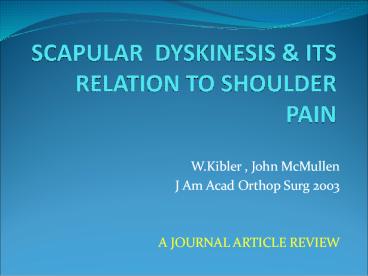SCAPULAR DYSKINESIS PowerPoint PPT Presentation
Title: SCAPULAR DYSKINESIS
1
SCAPULAR DYSKINESIS ITS RELATION TO SHOULDER
PAIN
- W.Kibler , John McMullen
- J Am Acad Orthop Surg 2003
- A JOURNAL ARTICLE REVIEW
2
ARTICLE INCLUDES
- Normal scapular function
- Scapular Dyskinesis
- Methods of classification
- Evaluation techniques
3
SCAPULAR DYSKINESIS
- It is defined as observable alterations in the
position of the scapula the patterns of
scapular motion in relation to thoracic cage - The term does not suggest etiology or define
patterns that correlate with specific shoulder
injuries - Classification of scapular dyskinesis patterns
and positions can help to determine treatment - Factors responsible
- Bony posture or injury
- contractures other flexibility problems
- Alteration in muscle function
4
SCAPULAR EVALUATION SHOULD INCLUDE
- Postural evaluation
- Resting Scapular Evaluation
- Dynamic Evaluation of scapular motion
- Corrective measures
5
STATIC EVALUATION
- SCAPULAR EVAL SHOULD BE DONE FROM POSTERIOR
ASPECT - FIRSTLY SCAPULA SHOULD BE EVALUATED IN STATIC
POSITION AS IN LONG-STANDING SCAPULAR
DYSKINESIS,RESTING WINGING MAY BE SEEN
6
DYNAMIC EVALUATION
- Should be examined in both elevating lowering
phase of motion - Muscle weakness mild dyskinesis is commonly
seen in lowering phase of arm movement - These commonly present as hitch or jump in
otherwise smooth motion of scapula and may be
more noticeable with several repetitions
7
KIBLERS CLASSIFICATION OF SCAPULAR DYSKINESIS
8
TYPE I
- PROMINENCE OF INFERIOR MEDIAL SCAPULAR BORDER
- ABNORMAL ROTATION AROUND TRANSVERSE AXIS
- INDICATES WEAKNESS OF LOWER TRAP, LAT DORSI,
SERR ANT - OR
- TIGHT PECT MINOR,MAJOR
9
TYPE II
- CLASSIC WINGING
- PROMINENCE OF ENTIRE MEDIAL SCAPULAR BORDER
- ABNORMALROTATION AROUND VERTICAL AXIS
- INDICATES WEAKNESS OF SERR ANT,RHOMBOIDS,ALL
FIBERS OF TRAP
10
TYPE III
- PROMINENCE OF SUPERIOR MEDIAL SCAPULAR BORDER
WITH SUPEROR TRANSLATION OF ENTIRE SCAPULA - INDICATES OVERACTIVITY OF LEVATOR SCAPULAE
IMBALANCE OF UPPER LOWER TRAP FORCE COUPLE
11
TESTS PERFORMED TO INDICATE WEAKNESS OF SCAPULAR
MUSCLES
- Isometric scapular pinch test
- Wall push- ups
- Lateral scapular slide test
- Scapular assistance test
- Scapular retraction test
12
ISOMETRIC SCAPULAR PINCH TEST
- Scapula can be normally held in retraction with
isometric pinch for 15 to20 seconds without
burning pain or muscle weakness - Scapular ms weakness may manifest as burning pain
in less than 15 sec.
13
WALL PUSH - UPS
- Wall push ups are effective for evaluating
serratus anterior strength - Abnormalities may be noted with 5 to 10 Wall push
ups
14
LATERAL SCAPULAR SLIDE TEST
- Inferior medial angle of scapula is palpated
marked on both the sides - The reference point on the spine is nearest
spinous process,which is marked - Distance is measured on both the sides in three
different positions,- - At resting position
- With hands on hips, with fingers anterior thumb
posterior - With the arms at 90 degrees with internal
rotation - A 1.5 cm asymmetry is the threshold for
abnormality
15
LATERAL SCAPULAR SLIDE TEST
16
SCAPULAR ASSISTANCE TEST
- During abduction or forward elevation, assistance
is provided by manually stabilizing the scapula
and rotating inferior border of scapula as the
arm moves - This proc simulates force couple activity of
serratus ant and lower trap - Elimination or modification of symptoms indicate
these muscles should be major focus in rehab.
17
SCAPULAR RETRACTION TEST
- The examiner stabilizes the medial scapular
border as the arm is elevated or externally - rotated.
- Relief of impingement symptoms is a positive test
18
Guidelines for Integrated Rehabilitation of
Scapular Dyskinesis Exercises Weeks
(estimate) Scapular Motion Thoracic posture
1-3 Trunk flexion/extension/rotation
1-3 Lower abdominal/hip extensor
1-5 Muscular Flexibility Massage 1,
2 Modalities (eg, ultrasound, electronic
stimulation) 1-3 Stretching (eg,
active-assisted, passive, PNF) 1-8 Corner
stretches (pectoralis minor) 1-3 Towel roll
stretches (pectoralis minor) 1-3 Levator
scapulae stretches 1-3 Sleeper position
stretches (shoulder ER) 1-3
19
Closed Kinetic Chain Co-contraction
Exercises Weight-shifting 1, 2 Balance
board 1, 2 Scapular clock 1, 2 Rhythmic
ball stabilization 2 Weight-bearing isometric
extension 1, 2 Wall push-up 2 Table
push-up 3-5 Modified to prone push-up
5-8 Axially Loaded AROM Exercise Scaption
slide 2-5 Flexion slide 2-5 Abduction
glide 3-5 Diagonal slides 2-6
20
Integrated Open Kinetic Chain Exercises Scapular
motion exercices plus arm elevation
3-8 Unilateral/bilateral tubing pulls with trunk
motion 4-8 Modified lawn mower series
3-6 Dumbbell punches with stride (progressive
height and resistance) 6-8 Lunge series with
dumbbell reaches 5-8 Plyometric Sport-Specific
Exercises Medicine ball toss and catch
6-10 Reciprocal tubing plyometrics 6-10
21
THANK YOU
- PRESENTATION ACKNOWLEDGEMENT
- DR. PALLAVI SHIVALKAR
- ASSOCIATE PROFESSOR,
- DR. D .Y PATIL COLLGE OF PHYSIOTHERAPY
- NERUL, NAVI MUMBAI
- THANK YOU MADAM.
- DR. AJIN JAYAN THOMAS

